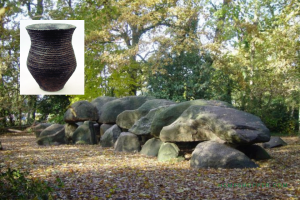2300 BCE: Beaker culture uses cannabis in The Netherlands

2300 BCE: Beaker culture uses cannabis in The Netherlands.
In 2007, archaeologists discovered a late Neolithic grave attributed to the Beaker culture (found near Hattemerbroek (NL), Gelderland; dated 2459-2203 BCE).
The name Beaker Culture is the consequence of the special characteristics of these inverted bell-shaped and profusely decorated vessels that have been found, generally in funerary contexts, in much of Europe: almost the entire Iberian peninsula, in the Mediterranean and Atlantic areas, The Netherlands and part of Central Europe.
The widespread cord decoration on these beakers may have been an advertisement of the beaker’s contents: the cord may have been made from hemp (Sherratt,1997a: p.397)1
They discovered , is well, spread over the bottom of the grave, the rests of an abundance of flowers. They conclude that the pollen found in the rests came most likely from cannabis plants.
Sherratt proposed that hemp could be use as an hallucinogenic together with other substances and drinks, like beer, mead or mixed drinks (Sherratt, 1997a: p.397)2
1. BECKERMAN, S.M.(2015): Corded Ware Coastal Communities. Using ceramic analysis to reconstruct third millennium BC societies in The
Netherlands.Leiden, Sidestone Press.
2. SHERRATT, A. (1995 b): Alcohol and its Alternatives. Symbol and substance in pre-industrial cultures. London,Routledg.
SHERRAT,A. (1997): Economy and Society in Prehistoric Europe: Changing Perspectives.Edinburgh University Press.
GOODMAN, J.: Consuming Habits. Drugs in History and Anthropology. London,Routledg.
VAZQUEZ CUESTA, A. (2005): Alcohol y Campaniforme. Cuadernos de Arqueología. Navarra, Universidad de Navarra (p- 87-114).
Research and text © Hempshopper Amsterdam.


 Hempshopper Amsterdam
Hempshopper Amsterdam 





